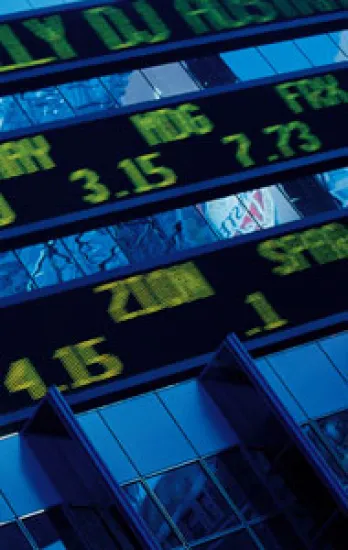Equity markets have exploded in recent years, not just in share and order volumes but also in the number of trading venues. That’s a mixed blessing for the institutional investors that have supported the formation of dozens of alternative sites now challenging the dominance of traditional, established exchanges: The competition puts downward pressure on the costs of executing big institutional trades but has vastly complicated the process of deciding where to go for the fastest and cheapest transaction.
For the better part of a decade, technology has solved that “best execution” puzzle — and with ever-increasing effectiveness. Sophisticated algorithms now require mere microseconds to size up conditions and identify market centers ripe for a trade. Then they set a series of transactions in motion through high-speed order-routing and execution management systems to exchanges and other trading platforms the world over; these in turn continually upgrade their infrastructures to accommodate the growing, algorithm-fueled demand.
But in the past year, market volatility has reached unprecedented heights; the Chicago Board Options Exchange’s volatility index, a measure of market expectations over the next 30 days based on options pricing, averaged about 28 through October. On October 24 it spiked to an intraday record 89.53. The new generation of trading systems have never confronted such conditions before, and they are not, market participants say, keeping pace.
“Algorithms are not performing in this environment as well as they did before,” observes James Morrow, COO of Dallas-based agency execution brokerage Capital Institutional Services. “Volatility makes it much more difficult to get a block [trade] done.” That means less hands-off trading and more reliance on human intervention, which raises the cost to the buy side.
“Human intelligence seems to do better when things get crazier, because it can bob and weave,” says Joseph Ritchie, CEO of Geneva, Illinois–based algo trading firm Fox River Execution Technology.
Rising costs, in part from the return of the human touch that had been receding in the recent automation boom, are evident in the 12th annual global transaction cost analysis conducted for Institutional Investor by New York–based research firm Elkins/McSherry, a subsidiary of Boston’s State Street Corp. In the 12 months through June, average costs of trade execution rose in 31 of the 47 countries surveyed. By contrast, in the year-earlier survey period that predated the credit crisis that struck in summer 2007, costs increased in only one of the 42 countries for which Elkins/McSherry could make year-over-year comparisons.The overall global average per trade was 40.86 basis points in 2007–’08, up from 40.45 in 2006–’07 and 40.44 in 2005–’06.
(Click on the following links see the complete 2008 data for the Elkins/McSherry 47-country universe , along with rankings of individual firms in trading of New York Stock Exchange and Nasdaq Stock Market stocks. The leaders in global trading are shown in the accompanying tables, as well as online.)
To be sure, with 16 countries still showing improvements in the 2007–’08 period, the era of automation-assisted cost reduction has clearly not reached its end. The U.S. continues to set the pace: NYSE stocks remain the most economical to trade in the world, with commissions, fees and market impact averaging a total of 13.89 basis points, versus 14.80 a year earlier. Next come stocks on Nasdaq OMX Group’s Nasdaq exchange, which average 17.51 basis points, down from 19.44. But the next-cheapest markets lost ground: Japan up to 21.50 from 15.83, the U.K. (sells only) to 22.65 from 19.78, France to 23.50 from 22.83 and Germany to 23.56 from 19.94.
The NYSE, the flagship of multinational giant NYSE Euronext, now trades a minority of its own listed shares, as the liquidity has shifted to the Nasdaq and alternative venues, but the NYSE has done its part to push institutional trading efficiency. Handling more than 500 million shares a day in blocks of 10,000 or more, the NYSE is “still the largest block destination on the Street, but we don’t always get credit for that,” says Joseph Mecane, the Big Board’s executive vice president and chief administrative officer for U.S. markets. Stealing some of that thunder are block-execution specialists like Fox River, Liquidnet and Pipeline Trading Systems, all ranking high in Elkins/McSherry’s brokerage league tables in terms of bettering global benchmark averages.
“This year has seen continued fragmentation and an increase of executions away from traditional exchanges through broker-established pools of liquidity and alternative trading firms,” says Elkins/McSherry president James Bryson. The all-electronic brokerages tend to excel when their performance is measured against the volume-weighted average price benchmark, he notes, because their commissions are low and bulge-bracket competitors “normally trend close to VWAP because they are such a large percentage of the total market volume.”
Fox River repeats as No. 1 among brokerages in NYSE trading, with a differential of 12.9 basis points from the VWAP benchmark. Fox River doesn’t do quite as well as it did a year earlier, when it came in at 13.6 basis points, but it is 3.3 basis points ahead of its nearest rival, Credit Suisse (9.6), which is followed by Weeden & Co. (6.9), Investment Technology Group (6.5) and Knight Capital Group subsidiary EdgeTrade (6.5). Fox River is also first in a category in which it did not rank last year: NYSE-trading brokerages benchmarked against arrival, or order-entry, price. Here, Fox River is 28.2 basis points ahead of the standard, followed by San Francisco–based Merlin Securities at 26.0 and EdgeTrade at 24.1.
EdgeTrade and Fox River are No. 1 and No. 2 in Nasdaq stock trading against the VWAP benchmark, at 14.6 and 14.1 basis points, respectively.
“The real problem in the past was that all the people had algorithms but none had the ability to prove that theirs was better than the alternative,” says Fox River’s Ritchie. He gets buy-siders’ attention by offering a guarantee with his algorithms: Fox River will make up the difference if its customer gets better performance from an existing algorithm. “We offer 100 cents on the dollar if we do worse, but then we want to split the advantage as we do better,” says Ritchie, emboldened by transaction cost analyses like Elkins/McSherry’s.
Bryson agrees that the current climate is good for firms that can offer human expertise: “In volatile markets buy-side firms want to work more with sell-side traders to get guidance on how to approach the market.” But that hasn’t prevented operators of dark pools — trading networks that do not display public quotes and that have stimulated electronic trading between buy-side counterparties — from holding their own. New York–based Liquidnet, for one, ranks fifth in global trading against the VWAP benchmark (16.4 basis points better) and sixth in arrival price (14.8; see tables). It is also eighth in Nasdaq trading against VWAP (4.1), and its New York rival Pipeline is seventh in Nasdaq stocks benchmarked against arrival price (13.0).
Don’t count algorithms out; they may be challenged, but they still have a crucial role to play, and developers are constantly working to enhance the tools’ sophistication, says Robert Gasser. CEO of New York–based Investment Technology Group, an execution brokerage, algo provider and dark-pool operator that ranks seventh among brokerages in global trading against VWAP, at 14.6 basis points, Gasser asserts that technology has proved capable of bridging the dark- and displayed-liquidity worlds, creating an aggregate view of markets that can help traders cope with high volatility. “If I am sitting in a dark pool and something is trading at the NYSE, I won’t miss that trade,” he says. “I have the ability to place orders across multiple venues simultaneously and respond dynamically.”
Jersey City, New Jersey–based Lord, Abbett & Co., the No. 3 asset manager in NYSE trading, 16.7 basis points better than the VWAP benchmark, sees neither algorithms nor fragmentation as a bad deal, says partner and director of equity trading Ted Oberhaus. “We used to have to go through a broker-dealer, but now I can use algorithms to access 30 to 35 market centers from my desktop,” he notes. “With fragmentation of liquidity you have markets competing, and you get a tighter spread.”
Joseph Wald, a managing director of EdgeTrade in Jersey City, says that algorithms are adapting to new demands beyond pure trade execution. “A couple of years ago, the focus was just on how good and effective algorithms were,” he says. Now they are being applied to “sourcing liquidity” across the fragmented markets, supporting tasks that human traders often have to take on under difficult conditions. Will Geyer, president and CEO of JonesTrading Institutional Services, a Los Angeles–based block-trading firm that stresses human expertise, says that in chaotic markets traders “need to hit bids or take offers to move on price points as they are available. Historically, when an investment manager made a decision, he could wait for a certain price point and calibrate the cadence of the trade. Now people are moving to deal with events like forced liquidation, and they have to move at all costs.”
New York–based agency brokerage Instinet, a subsidiary of Nomura Holdings of Japan, invests heavily in market microstructure research to sell clients on best-execution strategies, says co-CEO Anthony Abenante. The firm ranks sixth among NYSE-trading brokerages, at 6.2 basis points better than the VWAP average, and seventh in Nasdaq stocks, at 4.6, and its affiliate Nomura Securities Co. is fifth in global trading against the arrival price benchmark (17.3 basis points better) and No. 12 in global trading against VWAP (11.6).
“The work we do is geared to intraday risk and liquidity, finding the optimal point between market impact and opportunity cost,” says Abenante. He adds that Instinet, which operates a leading European dark pool, Chi-X, is extending its coverage to encompass multiasset trading, including listed options and futures, and credit derivatives in anticipation of their move onto exchanges under tighter regulatory oversight. “We will be instrument-agnostic by the end of this year,” he says.
At Lord Abbett, Oberhaus has streamlined the number of brokerage relationships over the past few years from 280 to 18 — the idea was to take high-cost firms out of the mix, leaving 15 percent of the trading to full-service brokerages — while diversifying his execution preferences.
He sticks with the NYSE for 17 percent of his business, regarding it as the most efficient place to trade around opening and closing times. “You need the human element to buy and sell stock in good sizes at those times” says Oberhaus, referring to the specialist system that smooths out order imbalances. NYSE Euronext’s Mecane says the specialist model “performed well when there was a huge amount of volatility around the open and close in September-October.”
Lord Abbett traders also use algorithms and crossing networks. The firm likes Pipeline, which has a switching engine that deploys up to 100 algorithm configurations to fill out orders not completed within the dark pool. But Oberhaus reserves special praise for Liquidnet, where, he says, “You can buy a stock in the middle of the spread without moving it — it has no market impact.”
To view the 2008 rankings of the top trading firms, click on the charts below:
New York Stock Exchange Trading Leaders
The Costs of Executing Trades in 47 Countries






